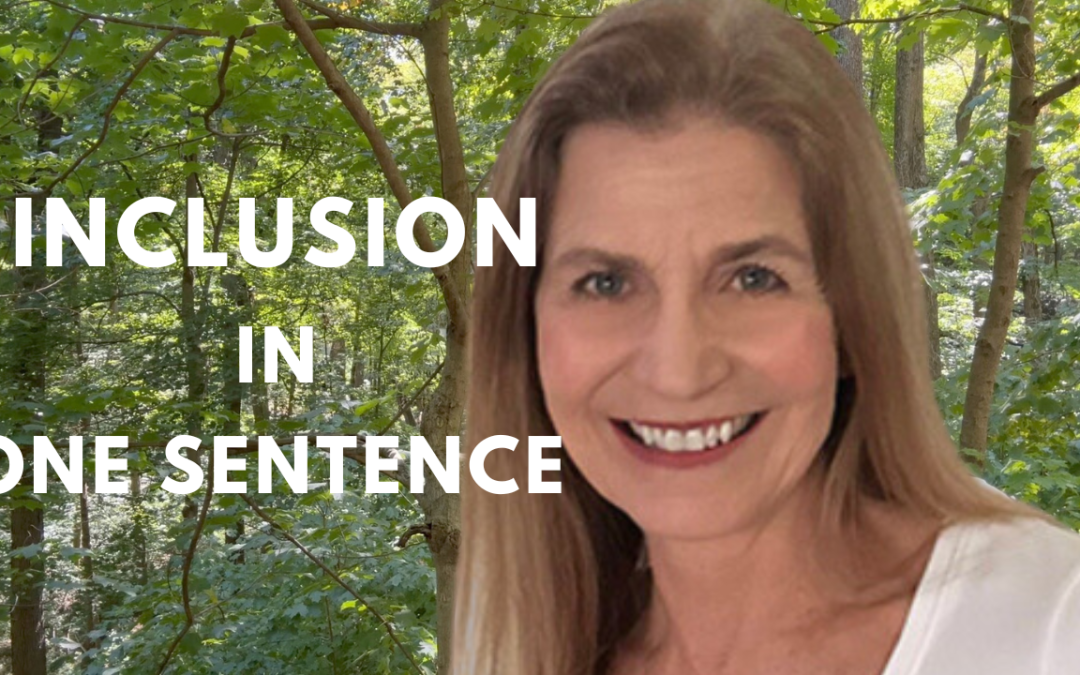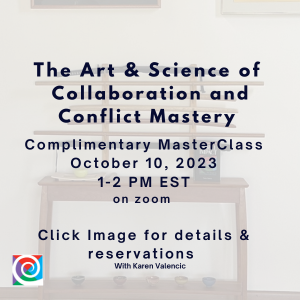Clikc on the smaller image to listen.
I’ve been thinking about inclusion a lot lately…It seems the lack of it is at the core of many of our challenges, even without DEI initiatives. I’d love your thoughts.
Edited transcript:
Inclusion is the greatest and the most difficult of the DEI equationt (that’s diversity, equity, and inclusion).
“People will NOT remember what you did or what you said,
but they will always remember how you made them feel.”
Attributed to Maya Angelou.
This quote is the essence that is at the heart of inclusion.
In this video, I am going to address three questions and give you a gift. The three questions are:
- Why is it the greatest?
- Why is it the hardest or most difficult?
- How do we know we actually have inclusion?
I’m Karen Valencic and I am the author and founder of Spiral Impact: the Power to Get It Done with Grace. I’ve worked for three decades with leaders and teams with a specialtyin collaboration and conflict mastery.
- Why do I see inclusion as the greatest of the three?
Exclusion creates resistance. When people feel excluded they tend to either flee or fight. Those are forms of dysfunctional conflict. When you’ve got that you lose out on a lot of stuff. Look around our world and our workplace and you can see the reaction to exclusion.
Inclusion brings people in it validates people and their ideas. People don’t have to have their way they just need to know that they’re valued and considered. So keep that in mind.
Also, the best ideas are always made better when they can stand the heat of diverse viewpoints you must have that to be at the top.
- Why is it difficult?
What I notice is that inclusion brings up fear. Ask yourself if you’re in this situation, what fears does inclusion bring up for you? Our brains are wired so when things change we do we go to fear to protect ourselves. But it’s probably not necessary in these circumstances.
I think fear also comes up if we don’t have time. We’ve got to get out there and deliver. This brings up that resistance to inclusion. So ask yourself what fear is this bringing up?
Remember even the best ideas get even better when they stand up to the heat of diverse viewpoints and diversity.
- How do you know if you’ve accomplished inclusion?
This is the trickiest of the three questions because you can make eye contact, you can listen, you can repeat back and acknowledge what somebody has said – and still not necessarily accomplished inclusion.
I think it goes back to that initial quote, “People won’t remember what you did or what you said, but they will remember how you made them feel.
That’s where authenticity and alignment with values comes in.
I’m going to give you a personal example. I was the odd man out in a decision with the group. They heard me. They acknowledged me. But at the same time I still did not feel included. I did not feel good about the situation. I believe a big part of it was the fact that the decision was not in alignment with our stated values and intention. There was a real big disconnect around alignment and that’s what made me feel .excluded.
When I asked directly, “How does this decision fit in with our values?” I wasn’t given a good answer. I did not feel included. Like I was on the outside.
So what do I do now? Me, I stay engaged I do believe that conflict is the source of all innovation we can master that by moving in and with it, but most people would just back off and exclude themselves or they keep fighting.
I think we have a lot of quiet quitting quiet firing because people when they don’t feel included there’s some dysfunctional conflict.
I would love to hear your input your responses and your questions please ask and I will respond.




Many organizations publish not only their values, but also their core competencies on their websites. Core competencies are expected skills and behaviors across the organization at all levels, in all functions.
It is critical to hire individuals who can tell stories that demonstrate all of the expected core competencies. I believe it is critical for organizations to incorporate inclusion, no matter their other core competencies. By doing so, they can ask interview questions (“Tell me a story about a time when you were deliberately inclusive. What did you do, what happened, and what was the outcome?”)
It is critical to incorporate inclusion at every step of the employee life cycle: selection, orientation, onboarding, development, and promotion. Anything less does not reinforce the core competencies (and probably the values) of the organization.
In the case if inclusion in a performance review, I suggest letting the individual set their own goals and explicitly describe how they will be inclusive.
It is very difficult to train/develop any competency that does not already exist in an individual’s behavioral or skill repertoire. An existing “preliminary” skill/behavior can be augmented, refined and perfected. In the case of an employee with no base competency, the individual will self select “out” or must be terminated.
The organization cannot truly know someone’s thoughts or beliefs. They can, however, require the demonstration of specific skills and behaviors.
Thank you Nancy! Great thoughts from a pro! I like the question, “Tell me a time when you felt excluded, what was that like for you?”
Also, I’ve observe people will select out of a culture that is clear about their values. It’s fascinating!